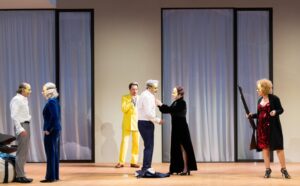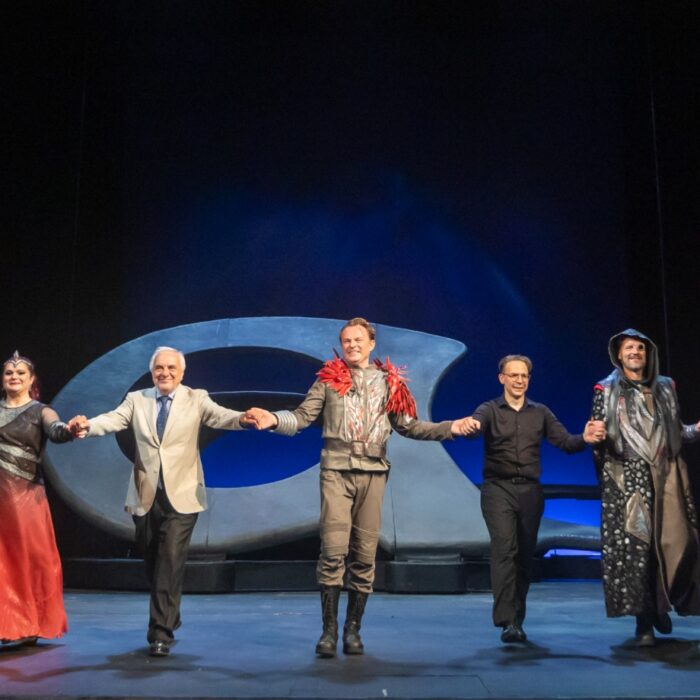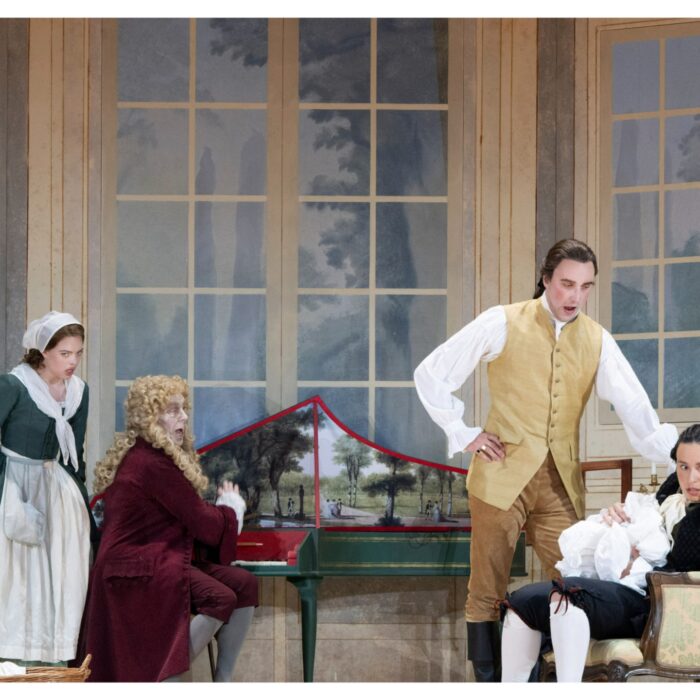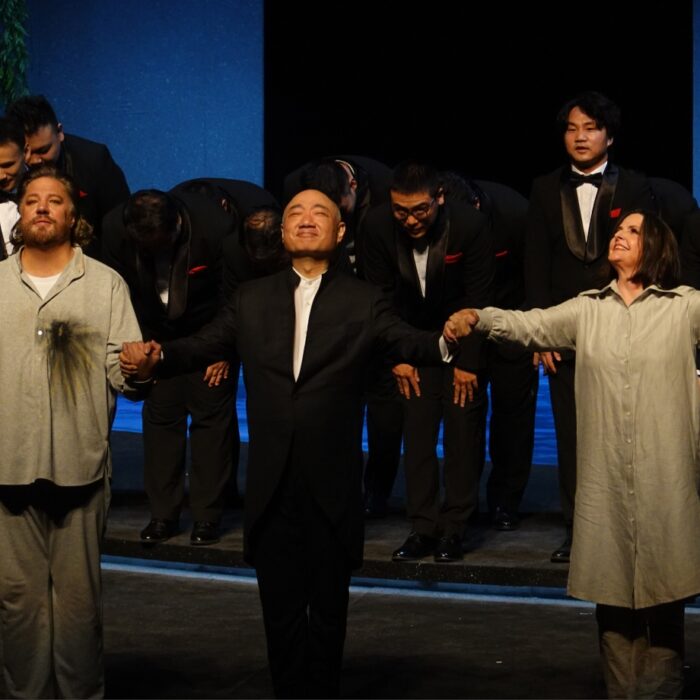
Festival d’Aix-en-Provence 2023 Review: Così Fan Tutte
By João Marcos CopertinoPhoto: © Monika Rittershaus
“Così Fan Tutte” has become the most uncomfortable of the three Mozart-Da Ponte operas. “Le Nozze di Figaro” has secured itself as a revolutionary and anti-establishment opera. “Don Giovanni” is unavoidable and unforgettable. “Così,” on the other hand, struggled to find its public for most of the nineteenth century. Its plot is often seen as both cruel and frivolous.
For Aix-en-Provence, “Così” is the opera for the festival’s 75th edition. In 1948, Gabriel Dussurget, with Countess Lily Pastré’s wallet, founded the festival with the goal of performing “Così” in France. The following year, with a production of “Don Giovanni,” the festival became a hit and it never abandoned its yearly Mozart production. For its 75th anniversary, “Così” is a compulsory invitee.
Dimitri Tcherniakov makes severe changes to the libretto of “Così” in an effort to rescue the opera’s capacity to critique moralism towards Love and Sex. Maybe his most insightful idea was to replace the youthful ingenuous lovers of the libretto with three couples way into their fifties and sixties. Fiordiligi and Dorabella are now two flashy, generic versions of uptight wealthy WASPy women who are as shallow as coffee-spoons. The young soldiers become two of the most obnoxious shadows of the tragedy of heterosexuality. Ferrando is senile menial, and Guglielmo is the annoying macho uncle that everyone has to endure at weddings and funerals.
The two couples are now in an unorthodox marriage resort commanded by Despina and Don Alfonso—a couple whose marriage dynamics move indifferently between sublime pleasure and brutal violence. They are the principals of Mozart’s long-lost “School of lovers.”
“Bananas”
Tcherniakov’s premise is bananas, but not so far away from the original craziness that is “Così.” The staging echoes three major films: Ingmar Bergman’s “Scenes of a Marriage” and “The Rite,” and Mike Nichols’ “Who’s afraid of Virginia Woolf?” By pointing to the frivolity possible even for long-married couples, Tcherniakov rescues this idea that potentially objects of Mozart/Da Ponte’s comedy are not only the ingenues, but also those whose souls have been molded by long habits of complacency, becoming more and more shallow as the years go by.
It is very easy to see what went wrong in this “Così.” I will get there, I promise. But, it seems few people actually wrote about what went well, i.e., its touching on this aspect of the superfluous organicity of marriage, especially when middle-aged people become more and more withdrawn from the world.
The staging is irregular, and most of the first act was tantalizingly boring. Nevertheless, in the second act, some things made some sense. The uncomfortable recitatives that succeed the balcony serenata were insightful. There, the dynamics of couple swapping with everyone, very aware of who’s who, by the way, gained colors of tense and fearful desire, suggesting that everyone actually wants to be with their original partners. For the first time in years, I saw a “Così” where the process of learning “love,” whatever “love” might be in a world of Bergman-style cruelty, is a forceful task to undertake. None of the characters actually have the strength to do it for themselves. They need as much support as they can get.
That said, this “Così” falls short because of its lack of attention to artistic details. The cuts and dramatic time are far from great. The story gets more and more non-sensical as it goes, trying to find a new ending to replace what was already an ironic and ambiguous solution. One cannot make ambiguity more ambiguous, and Mozart-DaPonte are hardly in need of the “help” they were solicitously offered. Most importantly, this is the ugliest staging in Aix-en-Provence. Whereas, Bergman’s films are beautiful, Elena Zaytseca’s costumes, on the other hand, were incoherent and impractical. What wealthy lady would repeat the same look on a Saturday night that she wore on Friday? Gleb Filshtinsky’s lighting does not change at all, making my eyes to bleed with three-and-a-half hours of emotionless and bland white-led lights. And, why do people in the 1980s have smartphones? It is tough to defend Tcherniakov when all of his artistic design seems careless.
Not Up to Par
As for the musical performances, things were not great. But, not as bad as most people advertise. Much has been written about how the singers’ ages affected their singing, which is a simplistic—and wrong—explanation of the real problem: musical direction.
One should avoid concluding that the singers’ age affected their ability to sing Mozart. I read more than once that Agneta Eichenholz’s age is betrayed by her struggles in singing Fiordiligi’s coloratura. She is fifty-one-years-old! Her voice and color-tone both sounded finer than when she sang “Lulu” at the Royal Opera House in 2009. Rainer Trost is one of the finest Mozart tenors. His voice, especially during “un’aura amorosa,” has more technical control than younger tenors I have seen this season. It is hard not to view claims about the singers’ ages as a mere reflex of organic ageism. What is funny is how, until a couple of decades ago, Mozart was not considered the exclusive province of youth.
My rule is usually that if all musicians show difficulties, especially when they have shown great competence elsewhere, the fault must lie in the musical direction. This mostly means it is the conductor’s fault, but not only. Thomas Hengelbrock did not have a good time in Aix-en-Provence, and everyone could tell. I will address his insolent mass in my next review. But, will remain solely with “Così,” because it was tough to hear.
This was a case where all the musicians showed the potential to do something way better than what was actually delivered. The result was an empire of sloppiness. Every phrase sounded poorly finished, and the audience watched everything with quivering hearts. If an aria or scene started okay, there was always the fear things would go awry very suddenly.
Let’s take the example of Trost’s “un’aura amorosa.” In a potentially good scenic move, Tcherniakov brings Dorabella back on stage, as if Ferrando is not only admiring his partner, but also begging her pardon through music. This decision shows some of the power of music to move, rather than merely reflect, the action in Mozart-Da Ponte’s operas. Trost was going fine, but then, Hengelbrock kept extending the tempi at the end of each musical sentence. The result was the tenor’s “a’s” became more and more exposed, making a moving aria into a mere pointless challenge for a tenor to tenere la voce.
This was the case of a conductor who seemed to actively be working against the music. The tragedy was precisely that one could see each singer trying to do their best against all odds. It was nice to hear how in the quintet, “Sento, oddio, che questo piede,” the singers made the complex sound web work properly. It was maybe the only pleasant musical moment of the performance. Other efforts were in vain. Claudia Mahnke was forced to sing Dorabella like a vulgar matron. Her “Prenderò quel brunettino che più lepido mi par” was forced at an inadequate tempi. Thus, masking all the beautiful colors and abilities of her instrument. Nicole Chevalier’s “Una donna a quindici anni” was boring, and it sounded fifteen minutes longer than usual. Georg Nigl tried to give Don Alfonso a lighter and whiter voice, maybe to stress the character’s age as if he was once a tenor. The result was an orchestra that covered all of his Italian articulations. He became a character without a text. Russell Braun tried to preserve his strength and toxic masculinity. He perhaps emerged the least hurt by all the night’s efforts. But, with no great moments.
However, none of the musical disasters rivaled the destruction of “Per pietá, ben mio, perdona.” This story is so incredible that I must disclose my witnesses. Eichenholz sang the most rhythmically inconstant rendition of the aria. This was entirely Hengelbrock’s fault because the winds of the Balthasar Neumann Orchestra could not play in tune or in time. As Eichenholz sang “che vergogna” (“what a shame”), a pigeon that was haunting the theater decided to stop flying and fell down dead between the seats of my partner and Brazilian critic Fabian Crepaldi! This was more than enough proof that poor musical performances are not vegan-friendly. Hengelbrock’s conducting, aligned with a lazy reading by Tcherniakov, proves how lethal bad opera performances can be.
Nonetheless, this “Così” might be avenged soon. In February 2024, the same production, hopefully slightly changed, will be performed at Théâtre de Châtelet in Paris. I plan to be there. The vocal cast is almost the same. Patricia Petibon replaces Chevalier as Despina. But, the orchestra is “Les Talents Lyriques” under Christophe Rousset’s direction. If my theory regarding the poor musical direction is right, we will have the proof next season.


